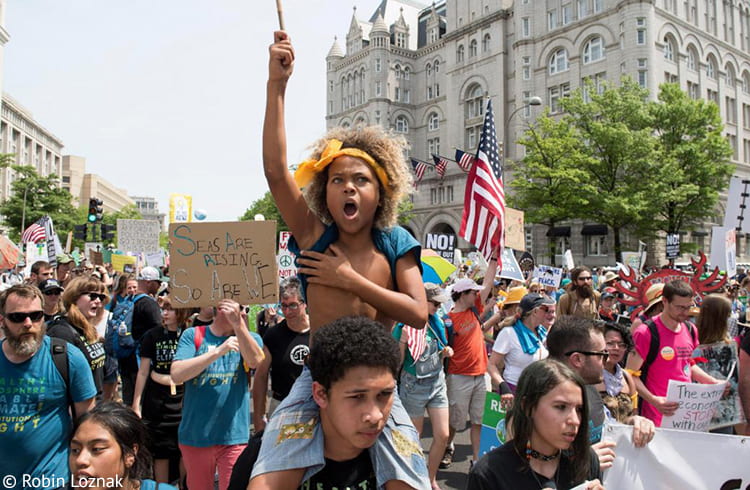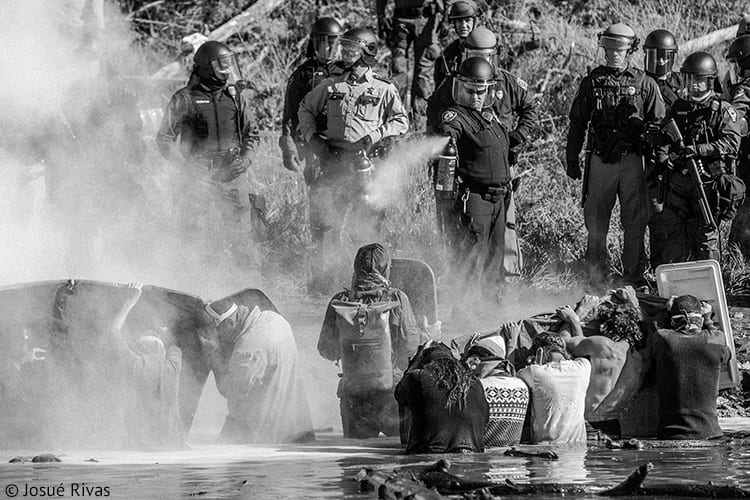Poor and Majority-Black Warren County, NC, Protests a Hazardous Waste Landfill
In 1978, it was discovered that a large quantity of polychlorinated biphenyls, highly toxic chemicals whose production had recently been banned in the U.S., was dumped illegally along roads in North Carolina. To dispose of the contaminated soil, the state selected a site in Warren County, one of North Carolina’s poorest counties with the largest percentage of African Americans. Legal opposition to the state’s decision failed, and trucks with the tainted soil began to arrive in Warren County in 1982. Hundreds of residents protested vehemently for weeks without success. The protests drew national attention and are considered as the beginning of environmental justice movement that fights for fair treatment of poor and minority communities in matters of environmental concern.
Image © Jenny Labalme
Hurricane Katrina’s Demographically Unequal Impacts
Hurricane Katrina, which struck the Gulf Coast in late August 2005, turned out one of the deadliest storms in the U.S. history, claiming estimated 1,800 lives. It was said that natural disasters did not discriminate by race, ethnicity and class, and Katrina did batter neighborhoods of different demographics, ravaging large swaths of New Orleans, 80% of which was flooded. Still, it has been shown that black and poor New Orleanians suffered disproportionately more. In large part, this was a result of historical systemic injustices that confined African American and poor communities to areas particularly exposed to flooding and pollution. However, the recovery process has also been harshly criticized as being biased against those people. Very large numbers of African Americans that were displaced by Katrina have not been able to return, and their share in the population of New Orleans fell from 67% in 2000 to 59% in 2018.
Image © David J. Phillip/AP
Youth Demand a Safe Climate
Scientific evidence that greenhouse gas emissions are rapidly pushing the Earth’s climate towards a very dangerous state is overwhelming. Without a swift and comprehensive action to curb these emissions, the world will soon face greatly increased risks to both nature and human health, wellbeing, security, and prosperity. By and large, the benefits of activities that generate climate-changing emissions as by-products have eclipsed concerns about the climate crisis, because the gains have been immediate and tangible, while the downsides have seemed vague and distant in space and time. A consequence is that generations least responsible for the emissions – the young and the yet unborn – will bear the largest costs for dealing with their aftereffects. Recently, youth have started to demand that adults in power begin having their best interests in mind when policies and decisions are made. They have brought lawsuits against their governments (in the U.S. and elsewhere) and a wave of school strikes has been sweeping the globe, seeking meaningful action on the climate emergency without delay.
Image © Robin Loznak
Hundreds of Mostly Black and Poor Chicagoans Die from Extreme Heat
On July 13, 1995, sweltering heat engulfed Chicago. Temperature rose to 106°F, but felt on the body as high as 126°F. Hot weather persisted for a week, straining the city’s infrastructure and the citizens’ physiology. So many became ill from the heat that soon numerous hospitals had no space left for new patients. By the third day of the heat wave, the city’s morgue capacity was greatly exceeded, and a fleet of refrigerated trucks had to be applied ad hoc to store the victims’ bodies until the medical examiners could attend to them. In the end, 739 deaths were attributed to the extreme heat. Racial difference in fatalities was astounding – the black-to-white mortality ratio was 1.5:1. It was explained not only by poverty, but also by social isolation and institutional abandonment of African American neighborhoods.
Image © Chicago Sun-Times
Native Americans Oppose the Dakota Access Pipeline
In 2016, thousands of Native Americans and their supporters gathered on the Standing Rock Reservation in North Dakota to protest against the construction of the Dakota Access Pipeline that would carry crude oil from the Bakken wells to a terminal in Illinois. The demonstrators were on the site for months and got into tense standoffs with the police, trying to block the $3.8-billion project as they feared drinking water contamination and violation of lands they held sacred. They claimed that the U.S. government had not properly assessed the project’s impacts on the local community and ecosystem before approving it, which led to tribal people’s lawsuit against the U.S. Army Corps of Engineers. In December 2016, Barack Obama’s administration stalled the disputed segment of the project, but in January 2017 President Trump, who was reported to have close financial ties with the pipeline developer, allowed it to proceed. Leaks were discovered already before the pipeline became fully operational, lending weight to the protesters’ fears.
Image © Josué Rivas
"Cancer Alley"
Along the Mississippi between Baton Rouge and New Orleans spans a large industrial corridor, which holds over a hundred petrochemical facilities in the immediate neighborhood of very poor and largely African American communities. Owing to the residents’ accounts of high cancer rates and other frequent maladies, it was dubbed Cancer Alley. The industry has denied responsibility for the alleged ill health of the people living next door, and environmental health science literature about links between the local industrial operations and the anecdotal reports of cancer clusters has been scant. However, no evidence of the links cannot be interpreted as evidence of no links, because environmental influences on cancer have been understudied, partly due to insufficient research funding and the limitations of currently available research technologies and methods. Still, some studies have associated higher pollution exposures in this region with an increased cancer risk and a greater incidence of childhood asthma and neurodevelopmental disorders.
Image © Julie Dermansky






